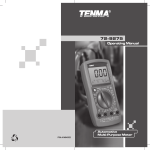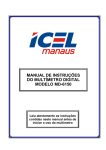Download UNI-T UT90C Specifications
Transcript
72-9375 110V P/N:110401102691 72-9375: OPERATING MANUAL Table of Contents Title Page Overview…………………………………………………2 Package Contents………………………………………2 Safety Information………………………………………2 Rules for Safe Operation………………………………3 International Electrical Symbols……………………….4 The Meter Structure…………………………………….5 Rotary Switch……………………………………………5 Functional Buttons………………………………..........6 Display Symbols…………………………………..........6 Measurement Operation……………………………....8 A. AC & DC Voltage Measurement……………….8 B. Measuring Resistance, Diodes, Continuity & Capacitance……………………………………..10 C. Frequency Measurement………………………14 D. AC & DC Current Measurement………………15 E. Power Charging…………………………………16 Operation of Hold Mode……………………………….17 The Use of Relative Value Mode……………………..18 The RESET Button…………………………………….19 The SELECT Button…………………………………...19 Sleep Mode……………………………………………..19 General Specifications………………………………....19 Accuracy Specifications……………………………….20 A. AC Voltage………………………………………20 B. DC Voltage………………………………………21 C. Resistance………………………………………21 D. Diode & Continuity…………………………….. 21 E. Capacitance Test……………………………….22 F. Frequency Test………………………………….22 G. AC Current………………………………………22 H. DC Current………………………………………23 Maintenance…………………………………………….23 A. General Service………………………………….23 B. Replacing the Fuses…………………………….24 1 72-9375: OPERATING MANUAL Overview This Operating Manual covers information on safety and cautions. Please read the relevant information carefully and observe all the Warnings and Notes strictly. Warning To avoid electric shock or personal injury, read the “Safety Information” and “Rules for Safe Operation” carefully before using the Meter. The Tenma 72-9375 (hereafter referred to as “the Meter”) is a 4000 counts, 3 3/4 digits solar powered auto ranging electrical tester with stabilized functions, safe design, and reliable performance. In addition to the conventional measuring function, such as DC/AC voltage, DC/AC current, resistance, diode, data hold and continuity, it is equipped with capacitance test, frequency test, relative mode and this meter is equipped with the flexibility of charging through 110V AC or 12-36 AC/DC or built-in solar energy cell. With this design, the Meter does not require a conventional battery, which reduces waste and cost associated with disposable batteries. PACKAGE CONTENTS Open the package case and take out the Meter. Check the following items carefully to see any missing or damaged part: Item Description Qty 1 English Operating Manual 2 Test Lead 1 piece 1 pair 3 Holster 1 piece In the event you find any missing items or damage to the included items, please contact your dealer immediately. Safety Information This Meter complies with standards IEC61010: in pollution degree 2, overvoltage category (CAT. II 2 72-9375: OPERATING MANUAL 1000V, CAT. III 600V) and double insulation. Use the Meter only as specified in this operating manual, otherwise the protection provided by the Meter may be impaired. In this manual, a Warning identifies conditions and actions that pose hazards to the user, or may damage the Meter or the equipment under test. A Note identifies the information that user should pay attention on. Rules For Safe Operation(1) Warning To avoid possible electric shock or personal injury, and to avoid damage to the Meter or to the equipment under test, adhere to the following rules: z Before using the Meter inspect the case. Do not use the Meter if it is damaged or the case (or part of the case) is removed. Look for cracks or missing plastic. Inspect the insulation around the connectors. z Inspect the test leads for damaged insulation or exposed metal. Check the test leads for continuity. Replace damaged test leads with identical model number or electrical specifications before using the Meter. z When using the test leads, keep your fingers behind the finger guards. z Do not apply more than the rated voltage, as marked on the Meter, between the terminals or between any terminal and grounding. z When the Meter working at an effective voltage over 60V in DC or 30V in AC, special care should be taken from there is danger of electric shock. z Use the proper terminals, function, and range for your measurements. z The rotary switch should be placed in the right position and no any changeover of 3 72-9375: OPERATING MANUAL z z z z z z z range shall be made during measurement is conducted to prevent damage of the Meter. Disconnect circuit power and discharge all high-voltage capacitors before testing current, resistance, diodes, continuity or capacitance. Start charging as soon as the power indicator appears. With a low battery, the Meter might produce false readings that can lead to electric shock and personal injury. When servicing the Meter, use only the same model number or identical electrical specifications replacement parts. The internal circuit of the Meter shall not be altered at will to avoid damage of the Meter and any accident. Soft cloth and mild detergent should be used to clean the surface of the Meter when servicing. No abrasives or solvents should be used on or in the meter. Turn the Meter off when it is not in use Do not use or store the Meter in an environment of high temperature, humidity, explosive, inflammable and strong magnetic field; the performance of the Meter may deteriorate. International Electrical Symbols AC(Alternating Current) DC (Direct Current) Low Battery Continuity Test Diode AC or DC Capacitance Test Fuse Grounding Double Insulated 4 72-9375: OPERATING MANUAL Warning. Refer to the Operating Manual Conforms to Standards of European Union The Meter Structure (see figure 1) ķ LCD Display ĸ Solar Panel Ĺ SELECT Button ĺ Rotary Switch Ļ HOLD Button ļ Input Terminals Ľ Relative Mode & RESET Button Rotary Switch Below table indicated for information about the rotary switch positions. Rotary Function Switch Position OFF Power is turned off V ȍ Hz μA , mA , A CHARGE AC/DC voltage measurement ȍ: Resistance measurement : Diode Test. : Continuity test : Capacitance test Frequency Test. AC or DC Current Measurement 110V MAX: 5 72-9375: OPERATING MANUAL Charge at 110VAC. 12-36 : Charge at 12-36 . Functional Buttons Below table indicated for information about the functional button operations. Button Measuring Function Operation Performed RESET Any rotary switch position except Hz and CHARGE Press RESET to enter and exit the mode in any measuring mode except in frequency and charge mode (Meter will beep) V A SELECT Switches between AC and DC voltage/current (DC is default) Switches between resistance, diode, continuity and capacitance measurements (Resistance is default) Any rotary switch position Press to enter and exit the Hold mode in any mode Display Symbols (see figure 2) 6 72-9375: OPERATING MANUAL No. Symbol Meaning 1 AC Indicator for AC voltage or current. The displayed value is the mean value. 2 Indicates negative reading. 3 Charge indicator CHARGE 4 AUTO The Meter is in the auto range mode in which the Meter automatically selects the range with the best resolution. 5 Data hold is active 6 The mode displays the present value minus the stored value The power is low. Warning: To avoid false readings, which could lead to possible electric shock or personal injury, replace the battery as soon as the battery indicator appears. Unit voltage (when charging is on) 7 8 V 9 10 ,k , M 11 Continuity buzzer Test of diode : Ohm (unit of resistance) 3 k : Kilohm (1 x 10 or 1000 ohms) 6 M : Megohm (1 x 10 or 1,000,000 ohms) 7 72-9375: OPERATING MANUAL µF, nF Hz, kHz, MHz V, mV A, mA, µA F: Farad (unit of capacitance) -6 µF: Microfarad. 1 x 10 or 0.000001 farads. -9 nF: Nanofarad. 1 x 10 or 0.000000001 farads. Hz: Hertz (The unit of frequency in cycles/second. kHz: Kilohertz. 1 x 103 or 1,000 hertz. MHz: Megahertz. 1 x 106 or1,000,000 hertz. Volts (unit of voltage) V: mV: Millivolt (1 x 10-3 or 0.001 volts) A: Amperes (amps). The unit of current. mA: Milliamp. 1 x 10-3 or 0.001 amperes. -6 µA: Microamp. 1 x 10 or 0.000001 amperes. Measurement Operation A. AC & DC Voltage Measurement (see figure 3) Warning To avoid personal injury or damages to the Meter from electric shock, please do not attempt to measure voltages higher than 1000VDC / 750VAC RMS although readings may be obtained. 8 72-9375: OPERATING MANUAL AC voltage measurement The AC voltage ranges are: 4.000V, 40.00V, 400.0V and 750.0V. To measure AC Voltage, connect the Meter as follows: 1. Insert the red test lead into the HzVȍ terminal and the black test lead into the COM terminal. 2. Set the rotary switch to V and press SELECT button to select AC measurement mode. 3. Connect the test leads with the object being measured. The measured value shows on the displayˈwhich is effective value of sine wave (mean value response). Note z At 400mV range, the Meter has an input impedance of 4000Mȍ. All other ranges the Meter has an input impedance of 10Mȍ. This loading effect can cause measurement errors in high impedance circuits. If the circuit impedance is less than or equal to 10kȍ, the error is negligible (0.1% or less). z When AC voltage measurement has been completed, disconnect the connection between the test leads and the circuit under test. DC voltage measurement The DC Voltage ranges are: 400.0mV, 4.000V, 40.00V, 400.0V and 1000V. To measure DC voltage, connect the Meter as follows: 1. Insert the red test lead into the HzVȍ terminal and the black test lead into the COM terminal. 2. Set the rotary switch to V ; DC measurement is default or press SELECT button to select DC measurement mode. 3. Connect the test leads across with the object being measured. The measured value shows on the display. 9 72-9375: OPERATING MANUAL Note At 400mV range, the Meter has an input impedance of 4000M . Except at 400mV range, all other ranges the Meter has an input impedance of 10M . This loading effect can cause measurement errors in high impedance circuits. If the circuit impedance is less than or equal to 10k , the error is negligible (0.1% or less). When DC voltage measurement has been completed, disconnect the connection between the testing leads and the circuit under test. B. Measuring Resistance, Diodes, Continuity & Capacitance Warning To avoid personal injury, never attempt to input over 60V in DC or 30V rms in AC. To avoid damages to the Meter or to the devices under test, disconnect circuit power and discharge all the high-voltage capacitors before measuring resistance, diodes, continuity & capacitance For testing capacitance, use the DC Voltage function to confirm that the capacitor is discharged. Resistance Measurement (see figure 4) The resistance ranges are: 400.0 , 4.000k , 40.00k , To measure 400.0k , 4.000M and 40.00M . resistance, connect the Meter as follows: 10 72-9375: OPERATING MANUAL 1. 2. 3. Insert the red test lead into the HzVȍterminal and the black test lead into the COM terminal. , resistance Set the rotary switch toȍ measurement (ȍ) is default (or press SELECT button to selectȍmeasurement mode) Connect the test leads with the object being measured. The measured value shows on the display. Note z The test leads can add 0.1ȍto 0.2ȍ of error to resistance measurement. To obtain precision readings in low-resistance measurement, that is the range of 400.0ȍ, short-circuit the input terminals beforehand, using the relative value RESET to automatically function button subtract the value measured when the testing leads are short-circuited from the reading. z For high-resistance measurement (>1Mȍ), it is normal taking several seconds to obtain a stable reading. z If ȍ reading with shorted test leads is not 0.5ȍ, check for loose test leads, incorrect function selection, or enabled Data Hold function. z The LCD displays OL indicating open-circuit for the tested resistor or the resistor value is higher than the maximum range of the Meter. z When resistance measurement has been completed, disconnect the connection between the test leads and the circuit under test. Testing Diodes (see figure 5) Use the diode test to check diodes, transistors, and 11 72-9375: OPERATING MANUAL other semiconductor devices. The diode test sends a current through the semiconductor junction, and then measures the voltage drop across the junction. A good silicon junction drops between 0.5V and 0.8V. To test a diode out of a circuit, connect the Meter as follows: 1. Insert the red test lead into the HzVȍterminal and the black test lead into the COM terminal. and press 2. Set the rotary switch toȍ measurement SELECT button to select mode. 3. For forward voltage drop readings on any semiconductor component, place the red test lead on the component’s anode and place the black test lead on the component’s cathode. The measured value shows on the display. Note z In a circuit, a good diode should still produce a forward voltage drop reading of 0.5V to 0.8V; however, the reverse voltage drop reading can vary depending on the resistance of other pathways between the probe tips. z Connect the test leads to the proper terminals as listed above. The LCD will display OL indicating open-circuit for wrong connection. The unit of diode is Volt (V), displaying the positive-connection voltage-drop value. z When diode testing has been completed, disconnect the connection between the testing leads and the circuit under test. Continuity Testing (see figure 6) 12 72-9375: OPERATING MANUAL To test for continuity, connect the Meter as below: 1. Insert the red test lead into the HzV terminal and the black test lead into the COM terminal. 2. Set the rotary switch to and press measurement SELECT button to select mode. 3. The buzzer does not sound if the circuit is disconnected and resistance value is > 100 . The buzzer sounds continuously if the circuit is in good condition, with resistance value 10 . 4. The nearest circuit resistance value shows on the display, the unit is . Note The LCD displays OL indicating the resistance of the circuit being tested is higher than 400 . The buzzer sounds if the RESET, SELECT or is pressed. When continuity testing has been completed, disconnect the connection between the test leads and the circuit under test. Capacitance Measurement (see figure 7) The Meter’s capacitance ranges are: 40.00nF, 400.0nF, 4.000μF, 40.00μF, and 100.0μF. To measure capacitance, connect the Meter as follows: 1. 2. Insert the red test lead into the HzV terminal and the black test lead into the COM terminal. and press Set the rotary switch to SELECT button to select measurement mode. The built-in equalized capacitance of the Meter will affect the reading accuracy. For better 13 72-9375: OPERATING MANUAL 3. accuracy of capacitance measurement, press button before measuring (the LCD will display 0). Connect the test leads with the object being measured. The measured value shows on the display. Note C. The LCD displays OL indicating the capacitor is short-circuited or the capacitor value being tested is overload. For testing the capacitor polarity, connect the red test lead to anode & black test lead to cathode instead of using test leads as mentioned above. Readings take longer when testing a capacitor value which is higher than 10μF range. When capacitance measurement has been completed, disconnect the connection between the testing leads and the circuit under test. Frequency Measurement (see figure 8) Warning To avoid personal injury, please do not attempt to input frequency voltage being tested higher than 30V. The measurement ranges are from 10Hz to 10MHz. To measure frequency, connect the Meter as follows: 1. 2. 3. Insert the red test lead into the HzV terminal and the black test lead into the COM terminal. Set the rotary switch to Hz. Connect the test leads across with the object being measured. The measured value shows on the display. 14 72-9375: OPERATING MANUAL Note When Hz measurement has been completed, disconnect the connection between the testing leads and the circuit under test. D. AC & DC Current Measurement (see figure 9) Warning Never attempt an in-circuit current measurement where the open-circuit voltage between the circuit and ground is greater than 110V. If the fuse burns out during measurement, the Meter may be damaged or the operator himself may be hurt. Use proper terminals, function, and range for the measurement. When the testing leads are connected to the current terminals, do not parallel them across any circuit. The current measurement has 3 measurement positions on the rotary switch: A , A and mA . The A has a 400.0 A and 4000 A range, with auto ranging; the mA has a 40.00mA and 400.0mA range, position has a 4.000A and with auto ranging; A 10.00A range, with auto ranging. To measure current, do the following: 1. Turn off power to the circuit. Discharge all high-voltage capacitors. 2. Insert the red test lead into the AmA or 10A terminal and the black test lead into the COM terminal. Use the 10A terminal and A range if the current value to be tested is an unknown. 15 72-9375: OPERATING MANUAL 3. 4. Set the rotary switch toȝA , mA or A . The Meter defaults to DC current measurement mode. To toggle between DC and AC current measurement function, press SELECT button. AC current is displayed as an mean value (calibrated against sine wave effective value). 5. Break the current path to be tested. Connect the red test lead to the more positive side of the break and the black test lead to the more negative side of the break. 6. Turn on power to the circuit. The measured value shows on the display. Note z For safety sake, the measuring time for high current should be less than 10 seconds for each measurement and the interval time between 2 measurements should be greater than 15 minutes. z When current measurement has been completed, disconnect the connection between the testing leads and the circuit under test, and remove the testing leads away from the input terminals of the Meter. E. Power Charging (see figure 10) Warning Start charging as soon as the power indicator appears. With a low battery, the Meter might produce false readings that can lead to electric shock and personal injury. To avoid damage to the Meter, please do not attempt to change the rotary switch during charging. 16 72-9375: OPERATING MANUAL To set up charging as follows: Charge at 110V AC 1. Insert the red test lead into the HzV terminal and the black test lead into the COM terminal. 2. Set the rotary switch to 110V MAX. 3. Insert the test leads’ probe tip into the 110V AC power supply respectively. 4. CHARGE shows on the display. 5. The charging time is around 15 mins. 6. Take the DC Voltage range as an example, the continuous working time is 90 mins Charge at 12-36V 1. Insert the red test lead into the HzV terminal and the black test lead into the COM terminal. 2. Set the rotary switch to 12-36V . 3. Place the test leads’ probe tip onto the 12-36V power supply respectively. 4. CHARGE shows on the display. 5. The charging time is at least 30 mins. 6. The continuous working time is 90 mins Charge by Solar Power Automatic charging can be completed through the built-in solar cell and a steady light source (preferably sunlight). Remarks: The display indicates “0.7V” as the rated charge voltage (us as a comparative value) The LCD will turn off when the power is low. When the LCD turned on or charging after 5 minutes during charging, press RESET to display the correct current charging voltage. When power charging has been completed, disconnect the connection between the testing leads and the supply power. Operation of Hold Mode Warning To avoid possibility of electric shock, do not use Hold mode to determine if circuits are without 17 72-9375: OPERATING MANUAL power. The Hold mode will not capture unstable or noisy readings. The Hold mode is applicable to all measurement functions. to enter Hold mode (meter will beep) Press Press again to exit Hold mode (meter will beep) is displayed. In Hold mode, The Use of Relative Value Mode mode applies to all measurement functions The except frequency and charge function it subtracts a stored value from the present value and displays the relative value ( ) as the result The definition is as follows: Relative value ( ) = present value – stored value For instance, if the stored value is 20.0V and the present measurement value is 22.0V, the reading would be 2.0V. If a new measurement value is equal to the stored value then display 0.0V. mode: To enter or exit Use rotary switch to select the measurement function before selecting RESET. If measurement functions change manually after RESET is selected, the Meter exits the mode. RESET to enter mode, and the Press present measurement range is locked and display the last measurement value as “0” as the stored value. Press RESET again to reset the stored value and exit Mode. Turn the rotary back and forth one time to return to auto ranging mode. This only applies to those functions having auto ranging. Pressing in any modes makes the Meter stop updating. Pressing again to resume updating. 18 72-9375: OPERATING MANUAL The RESET button The RESET mode applies only to the charge function. The LCD will be closed when the power is low. When the LCD is first opened or charging after 5 minutes during power charging, press RESET to display the correct current charging voltage. The SELECT button It uses for selecting the required measurement function when there is more than one function at one position of the rotary switch. Sleep Mode To preserve battery life, the Meter automatically turns off if you do not turn the rotary switch or press any button for about 30 minutes. The Meter can be activated by turning the rotary switch or pressing any button To disable the Sleep Mode, press SELECT while turning on the Meter. General Specifications Maximum Voltage between any Input Terminals and ground: Refer to different range input protection voltage. Fuse protection: 500mA, 250V, fast of A mA terminal type, 5x20mm Fuse protection: 10A, 250V, fast of 10A terminal type, 5x20mm Measurement Speed: Updates 3 times /second. Maximum Display: 3999 Temperature: Operating: 0 ~40 (32 ~104 ). Storage: -10 ~50 (14 ~122 ). Relative Humidity : 75% @ 0 to below 30 50% @ 31 to 40 Altitude: Operating : 2000m Storage: 10000m Power: Charge at 110VAC/ 50Hz/0.35W or 12-36 or solar cell 19 72-9375: OPERATING MANUAL Electro-Magnetic Field Interference: When field value is under 1V/m: total accuracy = assigned accuracy + 5% of the range. When field value is over 1V/m: there is no assigned accuracy Battery Deficiency: Display Negative reading:Display Overloading: Display: OL. Equipped with full icons display Manual / Auto ranging Polarity: Automatically display Dimensions (HxWxL): 179 x 88 x 39mm Weight: 380g (including holster and battery) Safety/Compliances: IEC61010: CAT. II 1000V, CAT. III 600V overvoltage and double insulation standard. Certification: Accuracy Specifications Accuracy ± a% reading + b digits guarantee for 1 year Operating temperature 23 ±5 Relative humidity <75% Temperature coefficient: 0.1 x (specified accuracy) / 1 A. AC Voltage Overload Range Resolution Accuracy Protection 4V 1mV 1000V DC ±(1%+5) 40V 10mV or 750V AC 400V 100mV continuous. 750V 1V ±(1.2%+5) Remarks: Input impedance: approx. 10M . Frequency response: 40Hz ~ 400Hz. Displays effective value of sine wave (mean value response). 20 72-9375: OPERATING MANUAL B. DC Voltage Range Resolution Accuracy 400m 0.1mV ±(0.8%+3) V 4V 1 mV ±(0.8%+1) 40V 10 mV 400V 100mV 1000V 1V ±(1%+3) Remark: Input impedance: At 400mV range: above 4000M All other ranges: approx. 10M C. Resistance Range Resolution Accuracy Overload Protection 1000V DC or 750V AC continuous Overload Protection 400 0.1 ±(1.2%+2) 4k 1 ±(1%+2) 40k 10 600Vp 400k 100 4M 1k ±(1.2%+2) 40M 10k ±(1.5%+2) Remarks: Open circuit voltage: approx. 0.45V D. Diode & Continuity Range Resolution Overload Protection 1mV 600Vp 0.1 Remarks: Range: At Open circuit voltage approximate 1.48V. Range: At Open circuit voltage approximate 0.45V. The buzzer does not sound when the resistance value is >100 (The circuit is disconnected or open). The buzzer sounds continuously when the 21 72-9375: OPERATING MANUAL resistance value is 10 working condition). E. Capacitance Test Range 40nF Resolution Accuracy 10pF 400nF 100pF 4μF 1nF 40μF 10nF 100μF 100nF F. Frequency Test Range 10Hz~ 10MHz ±(3%+5) ±(0.1%+3) 0.1 A 1 A 10 A 400mA 0.1mA 4A 1mA 10A 10mA Overload Protection 600Vp 30V rms Resolution Accuracy 400 A 4000 A 40mA 600Vp ±(4%+5) Resolution Accuracy 0.01Hz~ 10kHz Overload Protection ±(3%+10) Remarks: Minimum input amplitude : when 1MHz: 300mV when 1MHz: 600mV Maximum input amplitude: G. AC Current Range (The closed circuit is in ±(1.5%+5) ±(2%+5) ±(2.5%+5) Overload Protection Fuse 500mA, 250V, fast type, 5×20mm Fuse 10A, 250V, fast type, 5×20mm Remarks: Frequency response: 40Hz – 400Hz. At 10A Range: For continuous measurement 10 seconds (with 22 72-9375: OPERATING MANUAL 15 minutes rest intervals between tests) H. DC Current Overload Range Resolution Accuracy Protection 400 A 0.1 A Fuse 500mA, ±(1%+2) 4000 250V, fast 1 A A type, 40mA 10 A 5×20mm ±(1.2%+3) 400mA 0.1mA 4A 1mA Fuse 10A, ±(1.5%+5) 250V, fast type, 10A 10mA 5×20mm Remarks: At 10A range: For continuous measurement 10 seconds (with 15 minutes rest intervals between tests) MAINTENANCE This section provides basic maintenance information including battery and fuse replacement instruction. Warning Do not attempt to repair or service your Meter unless you are qualified to do so and have the relevant calibration, performance test, and service information. To avoid electrical shock or damage to the Meter, do not get water inside the case. A. General Service Periodically wipe the case with a damp cloth and mild detergent. Do not use abrasives or solvents. Make sure the power is off, and clean the terminals with a small brush or swab with a very small amount of contact cleaner or alcohol. Moisture or debris can create false readings. Turn the Meter off when it is not in use and take out the battery when not using for a long time. Do not store the Meter in an area of high humidity, 23 72-9375: OPERATING MANUAL B. high temperature, explosives, and strong magnetic field. Replacing the Fuses (see figure 11) Warning To avoid electrical shock or arc blast, which would cause personal injury or damage to the Meter, use specified fuses ONLY in accordance with the following procedure. To replace the Meter’s fuse: 1. 2. 3. Turn the Meter off. Remove the outer holster from the Meter. Remove all connections from the Meter’s terminals. 4. Remove the 3 screws from the case bottom, and separate the case top from the case bottom. 5. Remove the fuse by gently prying one end loose, and remove the fuse from its bracket. 6. Install ONLY replacement fuses with the identical type and specification as follows and make sure the fuse is fixed firmly in the bracket. Fuse 1: 10A, 250V, fast type, ij5x20 mm. Fuse 2: 500mA, 250V, fast type, ij5x20 mm. 7. Rejoin the case bottom and case top, and reinstall the 3 screws. Replacement of the fuses is seldom required. Blowing of a fuse almost always results from improper operation. This operating manual is subject to change without notice. 24


































